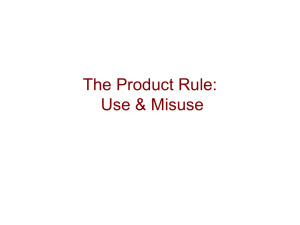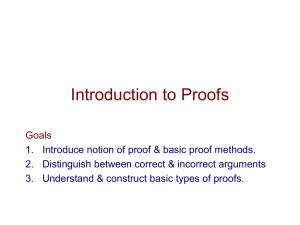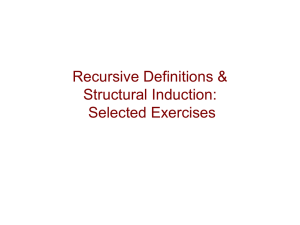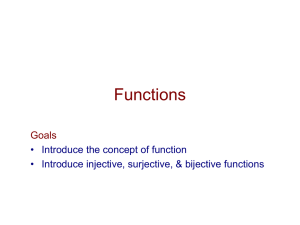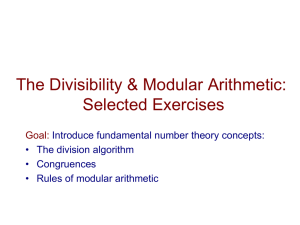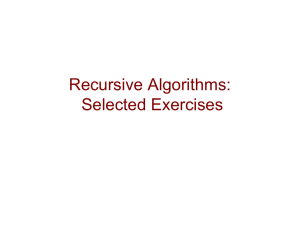1.2 - UCSB Computer Science
advertisement
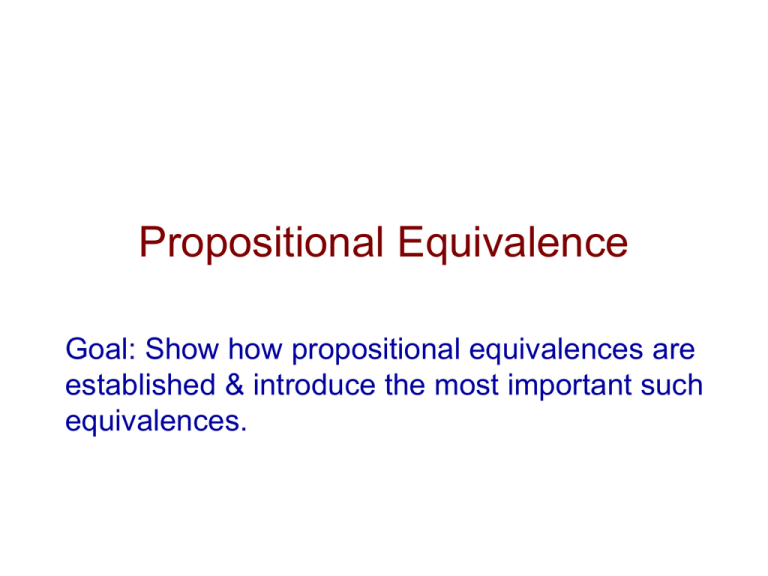
Propositional Equivalence
Goal: Show how propositional equivalences are
established & introduce the most important such
equivalences.
Equivalence
Name
p T ≡ p;
pF≡p
Identity
p T ≡ T;
pF≡F
Domination
p p ≡ p;
pp≡p
Idempotent
( p) ≡ p
p q ≡ q p;
Double negation
pq≡qp
Copyright © Peter Cappello
Commutative
2
Equivalence
Name
(p q) r ≡ p (q r )
(p q) r ≡ p (q r )
Associative
p (q r ) ≡ (p q) (p r )
p (q r ) ≡ (p q) (p r )
Distributive
(p q) ≡ p q
(p q) ≡ p q
DeMorgan
p (p q ) ≡ p
p (p q ) ≡ p
Absorption
p p ≡ T
p p ≡ F
Negation
Copyright © Peter Cappello
3
Exercise
A tautology is a compound proposition
that always is true.
Is the following a tautology?
( (p q) ( p r) ) (q r)
Copyright © Peter Cappello
4
The Satisfiability Problem
Satisfiability Problem
Given a function of boolean variables, is there an assignment of values
to its variables that makes it true?
Is f( p, q, r ) = ( (p q) ( p r) ) (q r) satisfiable?
Satisfiability is important in CS theory, algorithms, program correctness, AI,
hardware design, etc.
Algorithm
1.
Construct the truth table.
2.
If any assignment (row) evaluates to true, return true;
3.
Else return false.
If the formula has n variables, how many rows does the truth table have?
Copyright © Peter Cappello
5
An example satisfiability problem
• Let p( row, col, n ) denote the proposition
“Box( row, col ) contains number n.”
• Using such propositions, design a
compound proposition that is satisfiable
if & only if
1
3
n appears in some box, for 1 ≤ n ≤ 4.
4
1
Copyright © Peter Cappello
6
Problem
Give logical expressions for a 2-bit adder, where
• true corresponds to 1
• false corresponds to 0
For example, 01 + 11 = 100.
• Input:
Operand 1: a1 a0
Operand 2: b1 b0
• Output
s2 s1 s0
That is, define 3 Boolean functions:
• s 0 ( a1 , a0 , b1 , b 0 ) = ?
• s 1 ( a1 , a0 , b1 , b 0 ) = ?
• s 2 ( a1 , a0 , b1 , b 0 ) = ?
Copyright © Peter Cappello
7
Can you define a Boolean function in the C programming language?
boolean[] adder( boolean a1, boolean a0, boolean b1, boolean b0 ) { . . . }
Or, for an n-bit adder:
boolean[] adder( boolean[] a, boolean[] b ) { . . . }
For an n-bit adder, it may be useful to compute, for 0 ≤ i ≤ n, a sum bit,
si and a carry bit, ci.
For the sum bit, si, we may use:
si = ai bi ci-1, where c-1 = 0 and sn = cn-1.
The equation above is called a recurrence equation.
What is a recurrence equation for the carry bit, ci?
Copyright © Peter Cappello
8
Unraveling the for loop, suggests a diagram:
sn
sn-1
cn-1
s2
cn-2
an-1 bn-1
c2
s1
c0
c1
a2 b2
s0
a1 b1
0
a0 b0
Each box above has 3 inputs & 2 outputs, and is called a full adder.
A harder problem: Compute these sum & carry bits in parallel.
Copyright © Peter Cappello
9
END
Copyright © Peter Cappello 2011
10

